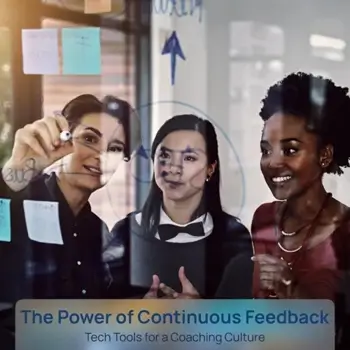Want to unlock your team’s full potential, boost productivity, and skyrocket employee satisfaction? The key lies in embracing a coaching culture powered by continuous feedback. In today’s business world, organizations understand the importance of feedback. Regular, constructive feedback increases employee engagement and performance. A recent Gallup study found that employees who get daily feedback from their managers are 3.2 times more likely to be engaged. This is compared to those who get feedback once a year or less.
Technology has made it easier to implement continuous feedback. There are now many tools to support managers and employees in giving and getting timely, relevant, and actionable feedback. In this article, we’ll explore the benefits of continuous feedback. We’ll also cover the key parts of a coaching culture and the tech tools. These tools can help you create a feedback-rich environment at your organization.
The Benefits of Continuous Feedback
Continuous feedback is a powerful tool for driving employee performance and engagement. Managers can help their team by giving regular, helpful feedback. This feedback can help team members see where to improve, set goals, and track progress. This approach has been shown to have a significant impact on key business metrics. A Deloitte study found that organizations with a strong feedback culture have a 14% lower turnover rate. This is compared to those without one.
In addition to reducing turnover, continuous feedback offers several other benefits:
- Improved employee engagement and motivation:
- When employees get feedback often, they feel valued and supported. This leads to more engagement and motivation.
- Enhanced performance and productivity:
- Regular feedback helps employees see their strengths and weaknesses. It lets them focus on areas to improve and get better results.
- Increased employee retention and job satisfaction:
- By investing in their development, organizations can boost employee satisfaction as well as reduce turnover.
- Better alignment with company goals and values:
- Regular feedback shows employees how their work supports the company’s goals. It also keeps them in line with company values.
- Fostering a growth mindset and continuous learning:
- A culture with lots of feedback encourages employees to embrace challenges to assist with an opportunity to learn from failures and keep developing their skills.
A culture with lots of feedback encourages employees to embrace challenges to assist with an opportunity to learn from failures and keep developing their skills.
Key Elements of a Coaching Culture
A coaching culture is one that values continuous learning, growth, and development. It’s a culture where feedback is a regular part of daily work life. To create a coaching culture, organizations should focus on these key elements:
- Regular one-on-one meetings between managers and employees:
- These meetings give managers and employees a chance to discuss progress, goals, and challenges. They should happen weekly or biweekly.
- Emphasis on constructive feedback and goal setting:
- Feedback should be specific, timely, and actionable. It should focus on behaviors and outcomes, not personal traits. Goals should be clear, measurable, and aligned with company objectives.
- Encouraging open communication and active listening:
- Managers should create a safe space for employees to share ideas, ask questions, and give feedback. Active listening skills, such as paraphrasing and asking clarifying questions, are essential.
- Providing opportunities for professional development and skill-building:
- A coaching culture supports continuous learning. Organizations should offer training, workshops, mentoring, and other development opportunities. These help employees grow and advance in their careers.
- Celebrating successes and learning from failures:
- Recognizing and rewarding achievements reinforces positive behaviors. At the same time, treating failures as learning opportunities encourages innovation and risk-taking.
By focusing on these key elements, organizations can create a coaching culture. This culture promotes continuous feedback, growth, and development. It leads to a more engaged, motivated, and high-performing workforce.
The Power of Continuous Feedback: Tech Tools to Drive Growth and Engagement
To support a coaching culture, organizations can leverage various tech tools. These tools make it easier to give, receive, and track feedback. They also support goal-setting, professional development, and performance management. Let’s explore some of the most popular categories of tools.
Performance Management Platforms
Performance management platforms help organizations streamline and automate their performance review processes. They provide features such as:
- Goal-setting and tracking
- Continuous feedback and recognition
- Performance reviews and assessments
- Analytics and reporting
Examples of performance management platforms include 15Five, Lattice, and BetterWorks. These tools allow managers and employees to set goals, give and receive feedback, and track progress over time. They also provide insights into individual and team performance.
Real-Time Feedback Apps
Real-time feedback apps allow managers and employees to give and receive feedback in the moment. They provide features such as:
- Instant feedback and recognition
- Peer-to-peer feedback
- Feedback templates and prompts
- Integration with communication tools like Slack
Examples of real-time feedback apps include Impraise, TinyPulse, and Officevibe. These tools make it easy for managers and employees to share feedback and recognition in real-time. They also provide analytics and insights into employee engagement and sentiment.
One-on-One Meeting Tools
One-on-one meeting tools help managers and employees structure and track their one-on-one conversations. They provide features such as:
- Meeting agenda templates
- Action item tracking
- Feedback and goal-setting prompts
- Integration with calendars and communication tools
Examples of one-on-one meeting tools include Soapbox, Fellow.app, and Hypercontext. These tools ensure that one-on-one meetings are productive and focused. They help managers and employees stay on track and follow through on action items.
Learning and Development Platforms
Learning and development platforms give employees access to training and development resources. They offer features such as:
- Online courses and workshops
- Personalized learning paths
- Skill assessments and certifications
- Integration with performance management tools
Examples include Udemy for Business, Coursera for Teams, and Skillsoft. These tools support continuous learning and skill development. They help employees grow and advance in their careers.
By leveraging these tech tools, organizations can create a feedback-rich environment. This environment supports a coaching culture and drives employee performance and engagement.

The Power of Continuous Feedback: How Tech Can Supercharge Your Coaching Culture
Implementing tech tools for continuous feedback requires careful planning and execution. Organizations should follow these steps to ensure a successful rollout:
- Assessing organizational needs and goals:
- Identify the key challenges and opportunities for feedback and coaching in your organization. Determine how tech tools can support your goals and objectives.
- Choosing the right tools for your team:
- Evaluate different tools based on their features, user experience, integration capabilities, and pricing. Consider piloting a few tools with a small group before making a final decision.
- Training managers and employees on effective use of the tools:
- Provide training and support to ensure that managers and employees know how to use the tools effectively. Emphasize best practices for giving and receiving feedback, setting goals, and tracking progress.
- Integrating feedback tools with existing HR systems and processes:
- Make sure the new tools fit well with your existing HR systems. These include performance and learning management systems. This will help create a cohesive employee experience.
- Monitoring adoption and measuring impact:
- Track usage and adoption metrics. Make sure the tools are used consistently across the organization. Measure the impact of continuous feedback on key metrics. These include employee engagement, performance, and retention.
Beyond the Annual Review: Patagonia and Adobe’s Continuous Feedback Models
Outdoor apparel maker Patagonia overhauled its performance reviews. They adopted a team focus, with employees setting financial and ambitious goals (OKRs). Quarterly check-ins replaced year-end ratings. A mobile app called HighGround was launched to support the new process.
Patagonia’s revamped reviews weren’t without challenges. Years of rethinking, retraining, and employee acclimation were required. However, the impact was significant. Financial performance strengthened, individual results improved, and employee engagement skyrocketed. Notably, teams and individuals with more check-ins and feedback did better. They consistently outperformed their peers on financial and talent metrics.
Adobe’s “Check-In” Success Story
Following suit, Adobe took a similar leap in 2012. They ditched annual performance reviews, ratings, and forced distribution curves. Instead, they embraced a new system called “Check-ins,” which emphasizes continuous feedback. This approach focuses on clear expectations from managers, collaborative feedback, and employee development.
Since adopting “Check-ins,” Adobe’s employee survey results are impressive. They observed a 10% rise in positive feedback. This feedback was about recommending Adobe and receiving valuable performance feedback.
Patagonia and Adobe’s journeys demonstrate the power of transforming performance management. Both companies invested significant time and resources into revamping their systems. However, this investment yielded undeniable improvements in employee engagement and performance. Copying these examples and using tech tools empowers organizations. It helps them to implement continuous feedback. This approach not only boosts employee performance but also drives strong business results.
The Future of Performance Management
Imagine a workplace where employees feel valued, supported, and motivated to reach their full potential. A place where continuous learning and growth are part of the company culture. This is the promise of a coaching culture powered by continuous feedback.
As technology advances, organizations have a unique opportunity to revolutionize performance management. By adopting the right tools and strategies, companies can create a feedback-rich environment. This environment drives engagement, productivity, and job satisfaction.
Transforming performance management may be challenging, but the rewards are substantial. Organizations that welcome continuous feedback and invest in employee development are better able to attract and keep top talent. They can also adapt to changing market conditions and achieve long-term success.
The future of performance management is clear. It’s time to leave behind the annual review. Instead, embrace a more agile, data-driven, and human-centered approach. By using technology and committing to a coaching culture, organizations can unlock their team’s full potential. This will help them thrive in the years ahead.


